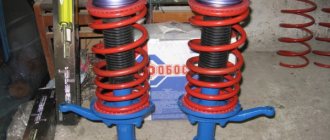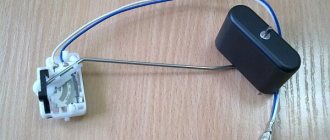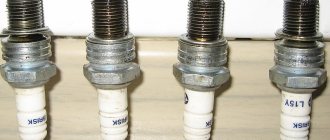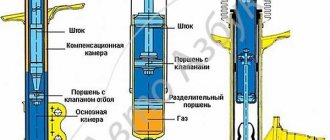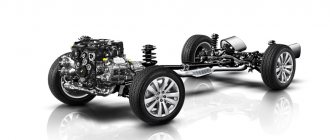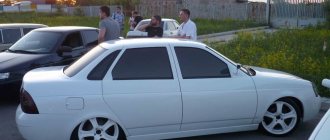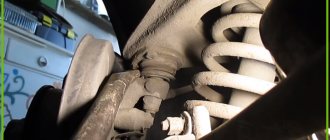09 February 2016 Lada.Online 208 417 81
The front and rear suspension of Vesta differs significantly from the one that AVTOVAZ used on Grant, Priora, Kalina, etc. All the reviews tell us that the new chassis design is better than before. However, during the first months of operation, the owners began to notice extraneous noises (knocks, creaks, rattles, crunches) in the front and rear suspensions of Vesta, which occur when driving over speed bumps or other road irregularities...
The most common shortcomings of the Lada Vesta car suspension
Drivers' complaints are caused by extraneous noises, squeaks and crunching sounds from the car's chassis. Most often they occur in the front part of the car, but many also complain about knocking from the rear suspension elements. The most common causes of these sounds are:
- Noise from front stabilizer struts.
Owners of the first Vesta cars began to notice extraneous sounds from the front suspension after several thousand kilometers. The reason for this turned out to be poor-quality stabilizer links. After considering consumer complaints, the manufacturer ordered that these parts be replaced free of charge in case of complaints.
- Rear shock absorbers knocking.
The rear struts knock when driving on rough roads. This is due to the fact that there is no insulating gasket between the shock absorber and the upper support, and metal hits metal when hitting an obstacle. The official service does not undertake to eliminate this deficiency, since it does not affect the driving performance of the car.
Grinding, creaking in the front suspension
A dull sound, as if the racks are touching the plastic, or a creaking sound reminiscent of rubber friction. The reason is the poor quality of the stabilizer bushings (No. 8) or insufficient lubrication of the muffler mounts .
It is enough to lubricate the gingerbreads (muffler mounts) with grease. There is no point in lubricating the rubber bushings of the stabilizer, because... this doesn't last long. You can solve the problem of front suspension squeaking like this:
- replace the standard stabilizer bushings with polyurethane ones (catalog number: 17012680).
- install analogue bushings.
- place a piece of rubber under the bushings (see video below).
- Since February, AvtoVAZ has been replacing the old-style stabilizer bar with a new one under warranty.
Question to AvtoVAZ: When will the problem of squeaking bushings be resolved? New cars from October-November continue to creak.
Answer: Improvements were introduced (replacement of rubber, lubricant) at the end of November 2016.
A knock in the front suspension may occur due to wear of the stabilizer struts (No. 7) (replacement), which should be replaced with new ones. This case is discussed in the video:
Also, knocking noise from the front of the car can come from the upper engine mount or from the brake caliper.
How to identify the cause of the noise yourself?
If the machine is under warranty, if you suspect any malfunction, you must contact your nearest service center. If the warranty has expired or this is not possible, you can try to determine the cause of the unpleasant noise yourself.
To do this, you need to hang the car wheels and move them in different directions. When conducting diagnostics, the following conclusions can be drawn:
- If there is play when the brake pedal is not pressed, then the wheel bearing needs to be replaced;
- If there is something wrong with the suspension, the play will not go away when you press the brake pedal;
- A ball joint defect can be suspected if the play occurs in the vertical plane. This sensation can also occur if the stand is poorly secured;
- Wobbling in the horizontal plane most often indicates a faulty tie rod end.
Having identified the causes of a creaking or rattling noise, it is necessary to eliminate it as soon as possible by replacing damaged parts. It is better to do this at a service station, where specialists will carry out reliable diagnostics and carry out repair work.
Front suspension. What might be a concern?
- Wheel bearings.
Wheel bearing noise can be detected by ear even by a less experienced driver. It howls and rustles when moving and, gradually increasing, begins to drown out all other noises in the cabin. To make sure that it is the bearing that is making noise, you need to turn the steering wheel a little when driving at speeds above 60 km/h. If the rumble appears in one steering position and stops in another, it means the bearing has definitely failed. You can also check this by lifting the car wheel and spinning it. If you hear a characteristic rustling sound, it means the bearing needs to be replaced.
- Stabilizer's pole.
Stabilizer links are the most vulnerable part of the suspension. Due to the poor quality of roads, they often fail and begin to produce a slight but constant noise from under the bottom of the car. You can determine if the struts are broken by resting the lever on the subframe and shaking the stabilizer. If during these actions a knock is heard and play is felt, it means that the stabilizer links are out of order.
These parts are usually replaced in pairs, and you can do it yourself. To do this, you need to hang the front wheels of the car, and using a 16 wrench, unscrew the hinge nuts, while holding them with a 5 hex wrench on the back side so that the hinges do not turn.
- Spherical bearing
The sound of a broken ball joint can be difficult to distinguish from other suspension noises. You can check the play of this unit by moving the suspended wheel in a horizontal plane. If the fault cannot be determined, you can insert a pry bar between the subframe and the lever and press on the resulting stop. This is the easiest way to identify a loose ball pore.
At the service center, the ball joint is replaced along with the lever and silent blocks. But these parts also exist for sale as a separate unit.
Replacing a ball is not an easy operation, so you can tackle it yourself only if you have the necessary tools and metalworking skills.
- Shock absorber.
Many drivers complain about the knocking of Lada Vesta shock absorbers, but their design itself eliminates this possibility. The telescopic strut consists of two cylinders that dampen vibrations while moving on uneven roads. When they break down, the car begins to “sit down”, the road holding is poor, all the unevenness and bumps become clearly noticeable, and the steering deteriorates. In this case, the outflow of liquid or gas from one cylinder to another is disrupted, and the shock absorber rod begins to make characteristic sounds that resemble knocking.
Visually, a breakdown of the oil shock absorber can be determined by drips on the casing, in the presence of which the part must be replaced immediately. You can also rock the car, focusing on the hood. Under normal conditions, after the impact ceases, the machine should swing once and stop moving. If this does not happen, the racks do not absorb as expected.
- Upper rack support
The upper mount of the front shock absorber contains a support bearing that can knock and howl when driving. You can identify a malfunction of this unit in the following way: swing the car in a vertical plane and put your hand on the support. If a part malfunctions, rattling and humming will be felt.
Another method requires completely dismantling the rack. This check can be done simultaneously with replacing the front shock absorbers. After removing the steering knuckle, you need to rotate the strut together with the spring in a circle. The crunching and grinding sound in the upper part of the assembly that occurs during this indicates that the support is faulty.
Like shock absorbers, it is advisable to change the upper supports at the station, since the process of dismantling and installing them is quite complicated.
How to understand that the calipers are knocking
The brake line begins with a pedal inside the car and ends with a pair of discs and pads. The driver’s force, when he presses the brake, is transmitted through a complex system, the penultimate link of which is the caliper on Vesta.
Spring from the “classic”. Photo source: https://lada-vesta.info/694-stuk-supportov-lada-vesta.html
The part performs important functions:
- Presses the pads against the brake disc when the pedal is depressed.
- Fixes the pads at a distance from the disc when there is no force on the brake.
- Keeps the pads strictly parallel to each other and the disc - when misaligned, the braking surfaces quickly wear out and braking deteriorates.
The calipers on the Lada Vesta must work smoothly and be technically flawless. But at twenty thousand kilometers, when the car is still under warranty, an extraneous sound from the brake system appears from under the bottom. At dealerships, the issue is not resolved, citing the design features of the unit and the permissible noise level.
Drivers themselves have to get rid of the problem. But first you need to find out whether it’s the calipers on Vesta that are really knocking, and not the valves or other engine elements. To find the irritant, expensive diagnostics are not needed.
Rear suspension knocking and noise
Unpleasant knocks from the rear suspension occur less often than from the front, but sometimes they also bother owners of Vesta cars.
The most common phenomena that can cause noise are:
- Rear beam silent blocks;
- Faulty rear shock absorber mounts or shock absorbers themselves;
- Lack of soundproofing gasket between the shock absorber and the upper support.
The first two problems are eliminated by replacing failed components. The knock of the strut on the support does not affect the driving performance and is not a breakdown, but a factory defect of Vesta. You can eliminate it by placing a purchased or self-made gasket between the parts that are closing and emitting an irritating sound.
Installation
It is extremely simple. As practice shows, it is not even necessary to remove the wheel - you can work by simply jacking up the car. After you place Vesta on the jack, you need to unscrew the 2 bolts that secure the stand. There are no nuts on the interior side, which greatly simplifies the task and makes it possible to work independently.
When the bolts are unscrewed, all that remains is to install the spacer and screw them back.
It is worth noting that some people separately purchase bolts longer than the standard ones in order to be sure of the quality of the fixation, but this is not necessary. Also, some owners treat the components with Movil or other lubricant.
The process of self-installation of spacers is clearly demonstrated in the video
As you can see, installing spacers under the supports of the rear shock absorbers of the Lada Vesta is quite simple, and it is by no means necessary to buy them, although the price of such products is low and their purchase will not hit the budget. But with spacers, the cabin becomes quieter, especially when driving over bumps.
Owner reviews about the Lada Vesta suspension
| Positive | Negative |
| The rubber blocks in the suspension squeaked in the rain from the very first day of purchase. I didn't pay attention when during the maintenance they asked if any suspension sounds were bothering me. I voiced my problem and they replaced my stabilizer bars for free. | I think the car is not worth the money. I chose between Polo, Solaris and Vesta. I took Vesta because it was cheaper, and the quality, as it seemed to me during the test drive, was the same. But, unfortunately, this is not the case. I was disappointed after the first 10 thousand mileage. The automatic transmission works terribly and the suspension rattles like an old Lada. |
| I have owned a Vesta SV Cross car for about a year now. I took it in a minimal configuration, but I’m happy with everything. The cross-country ability is really good, even on our broken country roads. The suspension doesn't make itself felt at all, I haven't changed anything in all this time, and nothing creaks. | In addition to the creaks of the interior and peeling chrome on the decorative elements, the suspension was terribly disappointing. The defective stabilizers were replaced under warranty. But after a while they began to creak again. The rear shock absorbers also make a lot of noise. And in general, the whole suspension is kind of flimsy, as if you were driving a Chinese car! |
| I drove about 3000 km on my Vesta. I go mainly to the dacha and fishing, so the load is almost always full. The suspension behaves decently, at least I didn’t notice any knocks, and during the technical inspection they said everything was fine. | 3 months after the purchase the front began to rattle. And soon the rear shock absorbers. I went to the service several times - they didn’t care about my problems! In the end they agreed to change the racks, but they were not in stock. I'm waiting for the third week, I'm already tired of visiting them! I don’t recommend buying Vesta at all, it’s better to take Rio and not know grief! |
| Overall I like the car. Beautiful, comfortable, roomy and most importantly - inexpensive. What worries me a little is that the steering wheel doesn't respond well when turning at high speeds. This is probably due to the high ground clearance. There are no comments on the suspension, it works properly, no noise was noticed. | In addition to the fact that the front windows were quickly scratched by poor-quality seals, after six months of use on the Vesta, clear knocking noises from the rear suspension began to be heard. It turns out that eliminating noise is not the responsibility of the warranty service, so I had to finish it myself. I bought special fluoroplastic spacers on the market. Installing them is not difficult, but why waste time, especially since the car is completely new? |
Conclusion
- The suspension of the Lada Vesta car is of good quality, but has some shortcomings.
- One of the most common reasons for contacting warranty service is knocking and noise from the front and rear suspension.
- Most often, the front stabilizers fail, as well as the rear shock absorbers, which begin to work noisily over time.
- It is possible to make a diagnosis yourself, but the result will not always be unambiguous. If this is possible, it is better to contact a service station to professionally diagnose and, if necessary, repair the car.

